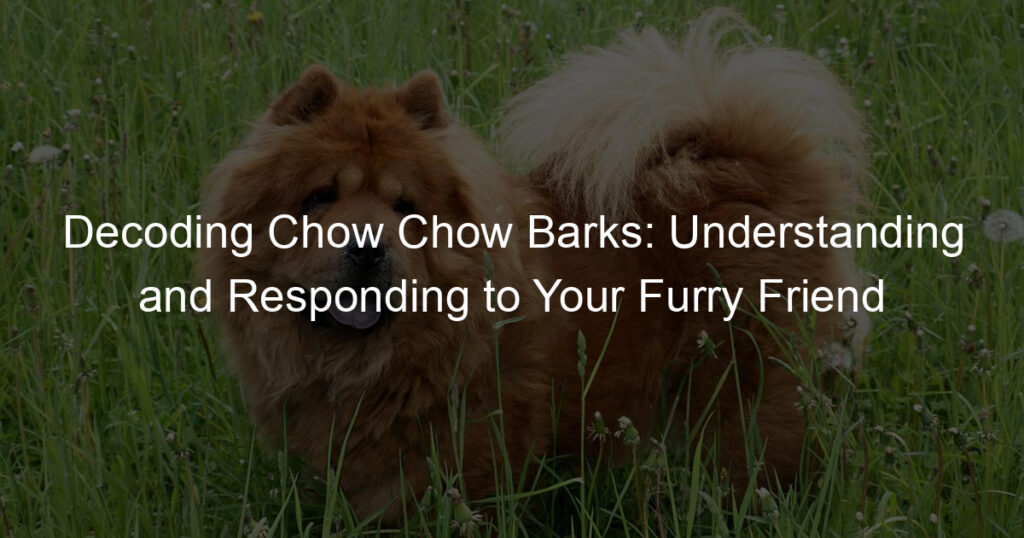Introduction to Chow Chow Dog Behavior
Chow Chows are a unique breed of dogs, known for their lion-like appearance and distinctive blue-black tongues. But beyond their physical attributes, it’s their behavior that truly sets them apart. This article aims to provide a comprehensive understanding of Chow Chow behavior, highlighting their key characteristics and unique traits.
- Understanding the unique behavior of the Chow Chow breed
- Key characteristics of Chow Chow behavior
The Chow Chow breed is known for its aloof and independent nature. Unlike other breeds, Chow Chows are not overly affectionate or playful. They are reserved, even with their owners, and can be wary of strangers. However, this does not mean they lack loyalty or love for their family. In fact, Chow Chows are known to be fiercely protective of their owners and can be quite affectionate in their own unique way.
Chow Chows are known for their stubbornness and intelligence. They are not easily swayed by commands and often require patient and consistent training. Despite their stubborn nature, Chow Chows are highly intelligent and can be trained to follow commands and routines. They are also known for their quiet demeanor. Unlike other breeds, Chow Chows do not bark excessively and are generally quiet and calm. However, they can be aggressive if they feel threatened or if their territory is invaded.
In conclusion, understanding the unique behavior of the Chow Chow breed is key to building a strong and loving relationship with your pet. Remember, every Chow Chow is unique and may not exhibit all the typical characteristics of the breed. Therefore, it’s important to spend time with your Chow Chow, understand their unique personality, and tailor your approach to training and care accordingly.
Understanding Chow Chow Barks
One of the most intriguing aspects of owning a Chow Chow is understanding their unique barks. Let’s dive into the science and common meanings behind these barks.
Interpreting Dog Barks: A General Overview
Before we delve into the specifics of Chow Chow barks, it’s essential to understand the general science behind dog barks and their common meanings.
- The science behind dog barks
- Common meanings of different types of barks
Dog barks are a form of vocal communication used by canines. They vary in frequency, duration, and amplitude, and each variation can have a different meaning. According to a study from the University of Sussex, dogs can communicate different emotions and intentions through their barks, such as fear, aggression, or excitement.
Generally, a rapid series of barks at a mid-range pitch indicates that a dog is perceived as a threat in their territory. A long string of solitary barks with pauses in between suggests that a dog is lonely. A high-pitched bark often signifies happiness or playfulness. However, these interpretations can vary based on the dog’s breed and individual personality.
Now that we have a general understanding of dog barks, we can delve deeper into the unique barks of the Chow Chow breed in the next section.
Chow Chow Barks: What Are They Saying?
Chow Chows are known for their unique barks. But what are they trying to communicate? Let’s decode the common Chow Chow barks and understand their context.
- Decoding common Chow Chow barks
- Understanding the context of Chow Chow barks
- Time of day: Barks at night could be a sign of loneliness or anxiety.
- Body language: A wagging tail or raised hackles can provide clues about what your Chow Chow is feeling.
- Surroundings: If there’s a stranger at the door or another dog in sight, your Chow Chow’s bark might be a response to these stimuli.
Chow Chows are not excessively vocal dogs, but they do have a few distinct barks that they use to communicate. Here are some common barks and their meanings:
| Bark Type | Meaning |
|---|---|
| Low, deep bark | This is a warning bark. Your Chow Chow might be sensing danger or an intruder. |
| High-pitched, repetitive bark | Your Chow Chow is likely excited or wants your attention. |
| Whining or whimpering | Your Chow Chow might be in pain or discomfort. |
Remember, every Chow Chow is unique and may have its own variations of these barks. It’s important to spend time with your dog to understand its specific communication style.
Context is key when interpreting your Chow Chow’s barks. A bark can mean different things in different situations. Here are some factors to consider:
Understanding your Chow Chow’s barks can strengthen your bond and help you meet their needs more effectively. Remember, patience and observation are key in this process.
Responding to Chow Chow Barks
Understanding and responding to your Chow Chow’s barks is a crucial part of building a strong bond with your pet. Different types of barks can indicate various needs or emotions, and knowing how to respond can help you effectively communicate with your Chow Chow.
Effective Communication with Your Chow Chow
Effective communication with your Chow Chow is not just about understanding their barks, but also about responding in a way that fosters trust and understanding. Here are some tips on how to do this:
- How to respond to different types of barks: Chow Chows use different types of barks to communicate various needs or emotions. A high-pitched, repetitive bark often indicates excitement or a need for attention, while a low, prolonged bark might indicate discomfort or fear. Responding appropriately to these barks – for example, by providing attention when your Chow Chow is excited, or comforting them when they’re scared – can help build a strong bond with your pet.
- Building a communication bridge with your Chow Chow: Building a communication bridge with your Chow Chow involves understanding their unique language and responding in a way that they understand. This might involve using specific tones of voice, body language, or even training commands. Remember, consistency is key when it comes to communicating with your Chow Chow. The more consistent you are with your responses, the more likely your Chow Chow is to understand and trust you.
By understanding and responding to your Chow Chow’s barks, you can build a strong bond with your pet and ensure that they feel understood and cared for. Remember, every Chow Chow is unique, so it’s important to pay attention to your pet’s specific behaviors and responses.
Chow Chow Training Tips
Training your Chow Chow can be a rewarding experience for both you and your pet. Here are some key tips to help you navigate this process:
- Training your Chow Chow to bark appropriately
- Dealing with Chow Chow behavior issues
Chow Chows are known for their distinctive bark, which can be a powerful tool for communication when used correctly. It’s important to train your Chow Chow to bark appropriately, so they can alert you to potential dangers without causing unnecessary noise.
Start by identifying what triggers your Chow Chow’s barking. Is it a certain sound, a person, or an event? Once you’ve identified the trigger, you can begin to train your Chow Chow to respond differently. This might involve rewarding them when they remain quiet, or redirecting their attention to something else.
Remember, consistency is key. It may take time, but with patience and persistence, your Chow Chow can learn to bark only when necessary.
Like all dogs, Chow Chows can sometimes exhibit behavior issues. These can range from excessive barking to aggression. The key to dealing with these issues is understanding what’s causing them and addressing the root cause.
For example, if your Chow Chow is showing signs of aggression, it could be due to fear or anxiety. In this case, it’s important to create a safe and secure environment for your pet. This might involve providing them with a quiet space where they can retreat when they feel overwhelmed, or introducing new people and experiences slowly and carefully.
If your Chow Chow’s behavior issues persist, it may be worth consulting with a professional dog trainer or a vet. They can provide you with personalized advice and strategies to help manage your Chow Chow’s behavior.
In conclusion, training your Chow Chow requires patience, understanding, and consistency. But with the right approach, you can help your Chow Chow become a well-behaved and happy member of your family.
Chow Chow Breed Characteristics
The Chow Chow breed, known for its lion-like appearance and unique blue-black tongue, is a dog breed that is full of surprises. Let’s delve into the physical characteristics and personality traits that make this breed so unique.
- Physical characteristics of the Chow Chow breed
The Chow Chow is a medium to large-sized breed, typically weighing between 45 and 70 pounds. They stand about 17 to 20 inches tall at the shoulder. Their most distinctive physical features include a dense double coat that can be either smooth or rough, and a unique blue-black tongue. The coat may be red, black, blue, cinnamon, or cream. Their eyes are deep set and almond-shaped, which gives them a very distinctive appearance. The breed has a strong, straight back and a tail that curls over the back. [source]
- Personality traits common to the Chow Chow breed
Chow Chows are known for their aloof and independent nature. They are often described as cat-like in their attitudes: they are most happy when they are given their space and are not overly demonstrative dogs. However, they are extremely loyal to their own family. Chow Chows are intelligent but not overly eager to please their humans, which can make them a challenge to train. They are good with children and can get along with other pets if they are socialized early and often. Despite their aloof demeanor, Chow Chows require a lot of attention from their owners and can become quite attached. They are not a breed for the novice dog owner, as they require a firm hand and a lot of patience. [source]
In conclusion, the Chow Chow is a unique breed with a distinctive appearance and personality. They are not the breed for everyone, but for the right owner, a Chow Chow can be a loyal and loving companion.
How to Train a Chow Chow
Training a Chow Chow can be a rewarding experience, but it requires patience, consistency, and understanding. Here are some basic guidelines to help you get started.
Basic Training Guidelines
Training a Chow Chow involves two key elements: establishing a routine and using positive reinforcement techniques. These methods are proven to be effective and can help your Chow Chow become a well-behaved and obedient companion.
- Establishing a Training Routine
- Using Positive Reinforcement Techniques
Consistency is key when training a Chow Chow. This breed thrives on routine and predictability. Start by setting specific times for training sessions, meals, walks, and rest. This will help your Chow Chow understand what is expected of them and when. Remember, training should be a daily activity, not a one-time event.
Positive reinforcement involves rewarding your Chow Chow for good behavior. This can be in the form of treats, praise, or extra playtime. When your Chow Chow performs a desired action, immediately reward them. This will help them associate the action with a positive outcome, encouraging them to repeat the behavior in the future. Avoid using punishment as a training method, as it can lead to fear and aggression.
Remember, training a Chow Chow takes time and patience. Don’t expect immediate results. Instead, focus on making steady progress and building a strong bond with your furry friend.
Addressing Common Training Challenges
Training a Chow Chow can be a rewarding experience, but it’s not without its challenges. Let’s explore two common issues that Chow Chow owners often face and provide some practical solutions.
- Overcoming stubbornness in Chow Chows
- Establish a routine: Chow Chows thrive on consistency. Establish a regular training schedule and stick to it.
- Use positive reinforcement: Reward your Chow Chow for good behavior. This can be a treat, praise, or a favorite toy.
- Be patient: Training takes time. Don’t rush the process. Remember, your Chow Chow is learning a new skill.
- Dealing with aggression issues
- Socialization: Expose your Chow Chow to different people, environments, and other animals. This can help reduce fear and anxiety.
- Positive reinforcement: Reward your Chow Chow for calm behavior. This encourages them to repeat the behavior in the future.
- Professional help: If your Chow Chow’s aggression continues, consider seeking help from a professional dog trainer or behaviorist.
Chow Chows are known for their stubbornness, which can make training a bit of a challenge. However, this trait can be managed with patience and consistency. Here are some tips:
Remember, every Chow Chow is unique. What works for one may not work for another. Experiment with different training methods and find what works best for your pet.
Some Chow Chows may exhibit aggression, but this is often a result of fear or anxiety. Here are some strategies to manage this behavior:
Dealing with aggression can be tough, but with patience and persistence, your Chow Chow can learn to manage their behavior.
In conclusion, training a Chow Chow requires patience, consistency, and understanding. By addressing these common challenges, you can help your Chow Chow become a well-behaved and happy member of your family.
Conclusion: Enhancing Your Relationship with Your Chow Chow
As we conclude, it’s essential to remember that the relationship between you and your Chow Chow is a lifelong commitment. It’s not just about training and understanding their barks, but also about appreciating their unique qualities and building a strong bond through understanding and communication. Let’s delve into these aspects.
- Appreciating the unique qualities of the Chow Chow breed
- Building a strong bond through understanding and communication
The Chow Chow is a breed like no other. Their lion-like mane, deep-set eyes, and unique blue-black tongue make them stand out in the canine world. But their uniqueness extends beyond their physical appearance. They are known for their aloofness, loyalty, and intelligence. These traits, while sometimes challenging, are what make a Chow Chow, a Chow Chow. By acknowledging and appreciating these unique qualities, you will be able to understand your furry friend better and form a deeper bond with them. Learn more about Chow Chow’s unique qualities here.
Building a strong bond with your Chow Chow goes beyond feeding and walking them. It involves understanding their unique language of barks, their likes and dislikes, and their specific needs. Communication is key. Talk to them, listen to their barks, and observe their body language. This will not only help you understand what they are trying to communicate but also make them feel loved and understood. Remember, a happy Chow Chow is a well-understood Chow Chow.
In conclusion, the journey with your Chow Chow is one of mutual growth and understanding. It’s about appreciating their unique qualities, understanding their communication, and building a strong bond. It may be challenging at times, but the rewards of a loyal, loving, and intelligent companion are worth every effort. Here’s to a beautiful and enriching relationship with your Chow Chow!














